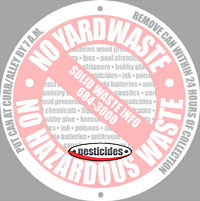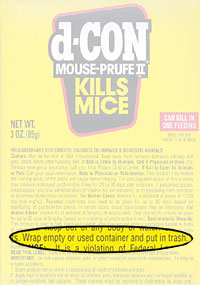As another summer eases into autumn, many of us are now enjoying the rewards of a season of gardening. We proudly face the August dilemma of figuring out what to do with all those tomatoes and zucchinis that are the result of our digging, planting, and weeding earlier in the season. More than a few of us also applied pesticides in our gardens and yards to keep the grubs down and insects away. When the season is over, what do we do with our half-used cans of insecticide? While we know pesticides have certain dangers, at least we know we can be safe and responsible if we follow the disposal directions on pesticide labels, right? Wrong. Lose one tomato and guess again.

What type of wrapping will protect the environment from this stuff?
Pesticide labels are dangerously outdated and need to be changed. As evidence has mounted that pesticides are essentially hazardous wastes, pesticide companies have not updated the disposal instructions on their products’ labels. Rather than instructing consumers to call their local solid waste agency to find out how to safety dispose of unused pesticides, the current labels instruct us to just “wrap in newspaper and throw in trash.”
Take a look at a pesticide label for yourself to witness a product suffering from schizophrenia and denial. Pesticides brag that they “kill bugs dead” and warn us to “wear gloves while using,” avoid inhaling fumes, or “keep out of reach of children.” But these same products change their identity when it’s time to dispose of any leftovers. Suddenly the pesticides aren’t so nasty. Merely a few layers of newsprint are all you need to protect people and the environment from these poisons!
Evidence of the dangers of pesticides continues to mount. Exposure to pesticides has been linked to a number of serious health conditions and diseases. A recent Stanford University study, for example, reported that pesticide exposure in the home and garden may increase the risk of developing Parkinson’s disease. Sanitation workers have been injured because garbage trucks are not designed to contain leaks from hazardous household products. Throwing half-empty bottles of pesticides in the trash puts sanitation workers at risk. Streams have been contaminated. Children have been poisoned.

Seattle garbage instructions — contradicted by labels on pesticides.
Not only are the disposal instructions on the present labels dangerous, but they directly contradict state and local policies. Some communities place instructions on trashcans explicitly informing people that pesticides should not be thrown away with the garbage. Product labels tell people the exact opposite. To make matters worse, the local agencies that are responsible for your solid waste can be held liable for pesticide contamination at a waste disposal facility. Thirteen communities in Southern California were recently ordered to spend over $32 million to clean up a landfill contaminated by household hazardous wastes.
The industry and our laws are starting to change in response to pesticides’ dangers. The manufacturer of Dursban, a major pesticide ingredient, has agreed to stop producing this dangerous substance. Massachusetts recently passed a law that bans the use of pesticides in schools and day care centers.
More good news is that the EPA is considering updating the disposal language on consumer pesticide labels. The public can submit their comments on this issue to the EPA through Aug. 14 — email comments to opp-docket@epa.gov with #OPP-00654 in the subject line, or get more info from the EPA. (Comments submitted after the deadline can still have an impact on EPA’s decision, so let your opinion be heard.) The bad news is that many pesticide manufacturers continue to argue that pesticides are safe enough to be tossed in the garbage along with pizza crusts and orange peels. It remains to be seen whether EPA will improve the labels and protect people, water supplies, and the environment.
It is time for pesticide manufacturers to live up to their responsibility and work with government agencies to reduce the impact of their products, just as many other industries are doing all across America. Government agencies around the country are looking to manufacturers to be environmental stewards, whether they produce electronics, paint, oil, beverage containers, or pesticides. Only with their support will we be able to move toward that ever elusive, but attainable, goal of sustainability. Changing labels so that consumers properly dispose of pesticides is a good next step.


